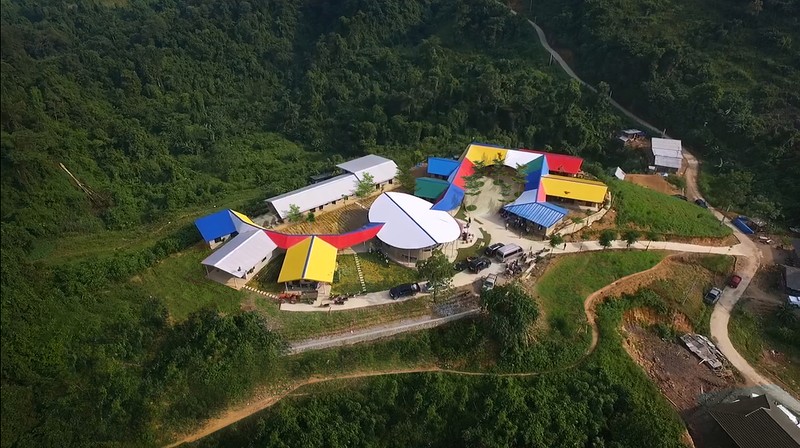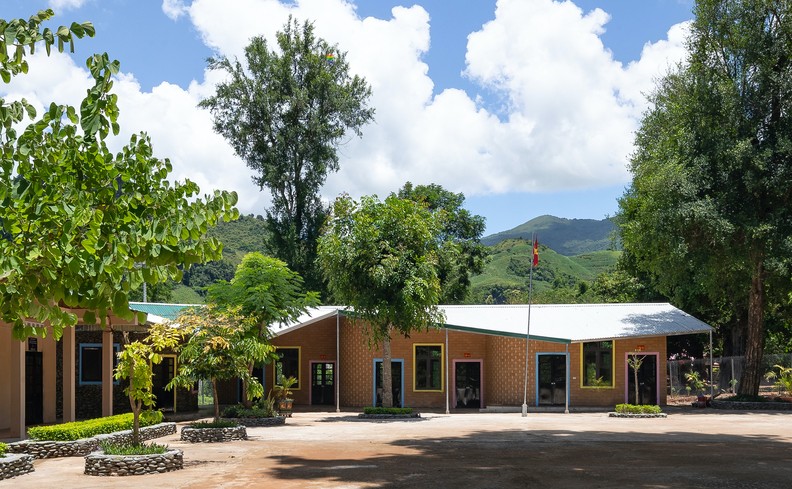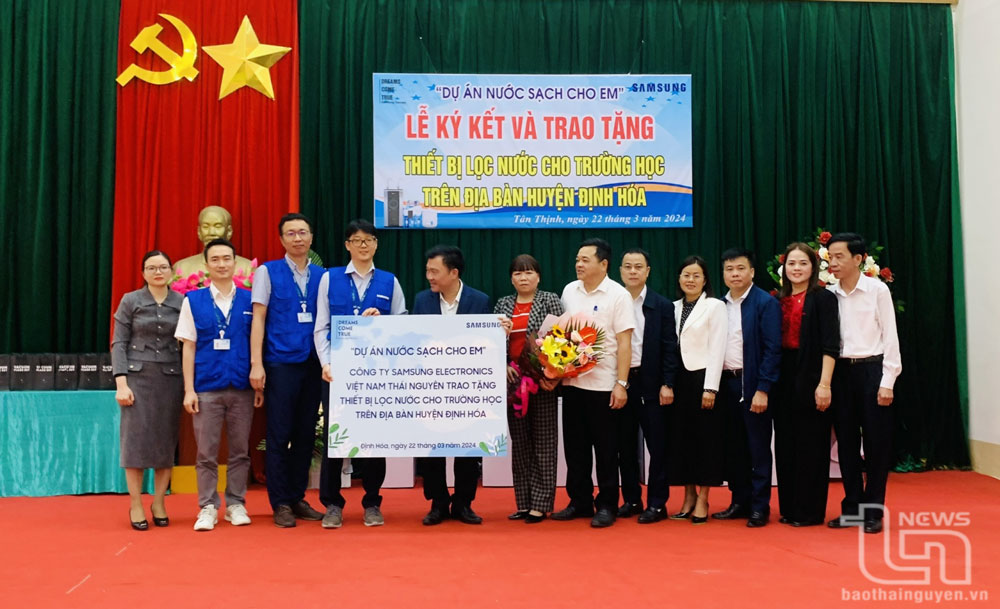School buildings often follow a standardised architectural style, with few projects reflecting the creative touch of architects. However, designing schools should respect local identity and culture, respond to the conditions and needs of each region, and encourage community involvement in preserving indigenous values.
 |
| An aerial view of Lung Luong Primary School in Vo Nhai District, Thai Nguyen Province (Photo: Archdaily) |
Nature and local culture: A source of inspiration in school architecture
Perched atop a rugged mountain peak, Lung Luong Primary School serves around 130 students. The previous school building was makeshift, with a torn canvas offering little protection from winter draughts. Classroom floors were bare soil, walls made of wooden pallets, and roofs covered with fibro cement. Bamboo wattle encased the gables, and during heavy rains, the piercing cold became unbearable.
The architectural office 1+1>2 led the school's reconstruction using social funding. After two years, the new school emerged like a vibrant jungle flower, characterised by its lively colours and contemporary design. Familiar local materials such as earthen bricks, bamboo, and rattan were utilised, ensuring a sustainable build.
From an aerial perspective, the school appears as modest interconnected houses, with an oval-shaped multipurpose hall uniting two rows of classrooms. The design enhances lighting, ventilation, and sound insulation, while incorporating essential facilities like a library, kitchen, dormitory, and restrooms.
Dinh Thi Hoa, a Tay ethnic minority teacher, observed that even after nearly a decade, the school remains well-maintained and inviting, making each day at school a joyful experience for pupils.
 |
| Na Pan School, Chieng Dong Commune, Yen Chau District, Son La Province |
Nestled in the town centre, Na Pan School faces a bustling inter-village road, while its rear opens onto the Nam Vat stream. The previous school consisted of three wooden structures with fibre-cement roofing. The school was reconstructed using locally sourced unbaked bricks, while the multipurpose hall was crafted from stream stones.
Funding for the reconstruction project came from both architects and community members, with 297 households and nearly 1,500 residents contributing over 3,000 workdays. Seeing their children thrive in a spacious and welcoming school, the locals recognised education’s significance—equating its value to necessities like food. Their efforts in building the school became an investment in their children's future.
Tham Luong School, Du Gia Commune, Yen Minh District, Ha Giang Province
Home to the Hmong ethnic community, Tham Luong School sits where Hmong villagers resettled after natural disasters forced their relocation. Their previous school was rundown, damp, and poorly lit.
Thanks to sponsorship from the Midas Foundation, the school was rebuilt in 2023. From afar, the new structure resembles rolling hills—an architectural homage to traditional Hmong houses clustered together. The simple yet functional design connects flexible living spaces with the cultural house, harmonising with its natural surroundings.
Locally quarried field stones serve as the primary building material, with community members actively participating in construction using traditional techniques.
 |
| A class at Tham Luong School, Du Gia Commune, Yen Minh District, Ha Giang Province (Photo: Archdaily) |
The stone walls, interwoven with pebbles and bricks, mimic the intricate patterns of Hmong brocade weaving. This method not only reinforces cultural expression but also acts as a natural wind barrier, ensuring classrooms remain warm in winter and cool in summer. Zigzagging corridors embrace a central courtyard, fostering connection between buildings.
Beyond its role as a schoolyard, the courtyard doubles as a gathering place for locals and visitors. Each element—from the roof to the walls and light slots—blends seamlessly with the landscape, mirroring the rhythm of the surrounding mountains. The project’s blue and white corrugated iron roofs blend harmoniously with the forest canopy, disappearing into the misty highland mornings.
Despite its modernisation, Tham Luong School retains a humble simplicity, honouring nature and local traditions. Its architectural excellence earned the International Architecture Award 2024 in the "School and University" category for sustainable design and cultural preservation.
Encouraging children to attend school
Surveying school projects in mountainous regions, Tran Trung Hieu observed that local communities perceive architecture as more than just a physical structure. To them, a building is a place they long to visit daily—a source of warmth, resilience, and emotional support against life's hardships.
Experts argue that schools in mountainous regions should differ from their lowland counterparts, as distinct terrain, climate, and cultural traditions shape architectural needs. Instead of uniform, multi-storey blocks, schools should ignite pupils' enthusiasm and curiosity, transforming every space into a dynamic learning environment.
Unfortunately, many mountainous schools mirror lowland designs, often consisting of long, multi-storey buildings.
Similarly, urban schools face their own challenges, often constrained by uniform high-rise blocks with classroom sizes ill-suited for modern teaching and interaction.
Renovation strategies must focus on creating inspiring, safe, and culturally integrated learning spaces. By embracing regional identity, architects can unleash their creativity to design schools that empower students and foster a deep connection between education and community.
NDO










Thông tin bạn đọc
Đóng Lưu thông tin